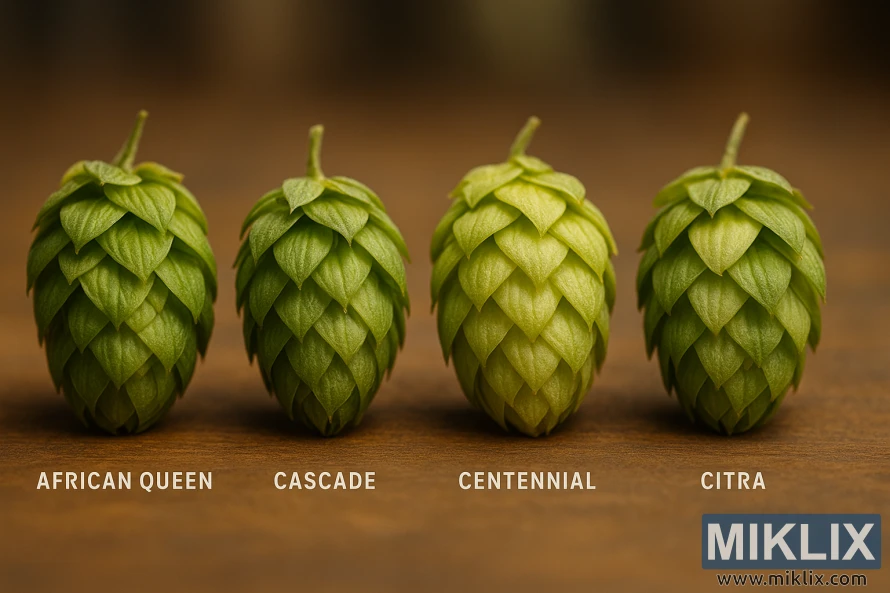Image: African Queen vs Other Hops
Published: August 1, 2025 at 12:27:19 PM UTC
Last updated: September 27, 2025 at 9:57:03 AM UTC
Close-up of African Queen hops compared with Cascade, Centennial, and Citra, highlighting textures, aromas, and unique brewing characteristics.
The photograph presents a meticulous study in hop diversity, offering a side-by-side comparison of four distinguished varieties: African Queen, Cascade, Centennial, and Citra. Each cone is positioned upright and isolated, arranged in a clean linear sequence across a smooth wooden surface that lends warmth and neutrality to the composition. The cones are illuminated by soft, directional lighting that enhances their textures, casting subtle shadows between the layered bracts and revealing the fine veining that gives each hop its characteristic structure. Against the slightly blurred background, the cones stand out with sculptural clarity, their form and color carrying the visual weight of centuries of brewing tradition and innovation.
At first glance, the differences appear subtle, but closer inspection reveals a world of variation. The African Queen cone, placed at the left, possesses a slightly elongated shape, with bracts that taper gently toward the tip, overlapping in a precise, almost geometric pattern. Its surface has a rich green hue, suggesting vitality and a resinous density within. This hop, hailing from South Africa, brings with it not only its striking appearance but also its distinct aromatic signature, known for berry-like fruitiness layered with herbal and woody undertones.
Beside it, the Cascade cone presents itself with a rounder, fuller body. Its bracts overlap in slightly looser tiers, giving it a softer outline when compared to the taut precision of African Queen. The Cascade variety, developed in the Pacific Northwest, is celebrated for the way its citrus-forward character reshaped American brewing in the craft beer revolution. Here, even in its physical form, there is a suggestion of accessibility, an openness that mirrors its bright, grapefruit-like profile and floral accents.
The Centennial cone, placed third, seems to strike a balance between the bold structure of African Queen and the approachable softness of Cascade. Its bracts are more tightly layered than Cascade’s, yet not as sharply pointed as those of African Queen. Its color leans slightly lighter, hinting at the resinous lupulin nestled within. Known as the “Super Cascade,” Centennial’s physical symmetry here mirrors its balanced flavor profile, which combines floral brightness with a firm bitterness that makes it versatile in a wide range of beer styles.
On the far right sits Citra, arguably the most iconic modern hop of the group. Its cone has a slightly more compact, bulbous shape, with dense bracts overlapping in neat tiers. The light plays across its surface, accentuating a vivid green vibrancy that hints at the explosion of aromas within. True to its reputation, Citra embodies intensity—tropical fruit, mango, passionfruit, and citrus all bundled into one hop variety that revolutionized modern IPAs. Even in this still-life presentation, the hop suggests abundance and power, a small vessel packed with extraordinary aromatic potential.
The deliberate arrangement of these four hops transforms the photograph into both an educational comparison and an artistic composition. Each cone is labeled in clean, unobtrusive type, grounding the image in a sense of scientific clarity. Yet the lighting and shallow depth of field elevate the scene beyond technical documentation, imbuing it with an aesthetic elegance. The blurred background ensures the cones remain the sole focal point, allowing viewers to appreciate the natural artistry of their design while simultaneously engaging with their cultural and brewing significance.
In the end, the photograph communicates both the precision of hop study and the romance of brewing. By isolating these four varieties—each iconic in its own way—it invites reflection on how something as small and unassuming as a hop cone can define entire beer styles, influence brewing traditions across continents, and inspire generations of brewers and drinkers alike. It is not merely a still-life but a quiet celebration of diversity, history, and the continuing evolution of flavor in the world of beer.
The image is related to: Hops in Beer Brewing: African Queen

